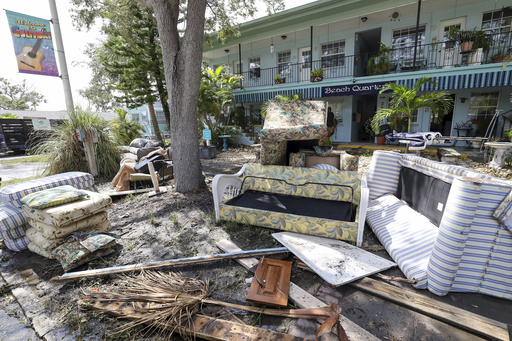A week following the devastating impact of Hurricane Helene on the Southeastern U.S., homeowners in the hardest-hit areas are facing the daunting task of figuring out how to cover the costs of the flood damage caused by one of the most deadly storms to hit the mainland in recent years. Hurricane Helene, a Category 4 storm that made initial landfall on Florida’s Gulf Coast on September 26, unleashed trillions of gallons of water across multiple states, leaving behind a trail of destruction spanning hundreds of miles inland. According to data from the National Hurricane Center, over 200 individuals have lost their lives in what stands as the most fatal hurricane to strike the U.S. mainland since Hurricane Katrina.
The impact of the storm was particularly severe in Western North Carolina and the Asheville area, with widespread flooding that obliterated buildings, roads, utilities, and land in a manner that caught many off guard. Inland areas in parts of Georgia and Tennessee also experienced significant damage from the storm. The Oak Forest neighborhood in south Asheville, known for its tall trees and 1960s era ranch-style homes on spacious lots, saw destruction as trees came crashing down on houses during Helene’s passage through western North Carolina.
One resident, Julianne Johnson, recounted the terrifying experience of a giant oak tree falling across their yard, narrowly missing their home but causing damage to the roof and flooding in the basement. While roof and tree damage are typically covered by standard home insurance policies, many homeowners like Johnson lack flood insurance for the ensuing water damage, leaving them uncertain about how to address that aspect of the destruction.
Insurance professionals emphasize that while home insurance may safeguard against certain types of damage, it usually does not cover flood-related losses. The primary provider of flood insurance for residential properties is the National Flood Insurance Program managed by FEMA, as private insurance companies often do not offer flood coverage. In the case of North Carolina, there are a considerable number of flood insurance policies in force, yet the coverage is generally more concentrated in coastal regions rather than areas like the Blue Ridge Mountains where the impact of Hurricane Helene was most severe.
As survivors of Hurricane Helene grapple with the aftermath, the realization that many may not fully recover financially without flood insurance sets in. Assistance from charities may aid some individuals in rebuilding, but many could be left to navigate the recovery process on their own, potentially facing foreclosure or bankruptcy. The private home insurance market, meanwhile, is expected to weather the storm due to its focus on covering wind damage from hurricanes rather than flood-related issues.
Experts predict insurer losses from Hurricane Helene to range from $5 billion to $8 billion, significantly less than the damage caused by previous storms. The lack of flood insurance coverage in many affected inland communities underscores a significant insurance gap in the country, leaving numerous homeowners vulnerable to financial devastation in the event of a flood.
Calls for a national disaster insurance program akin to the Affordable Care Act in the health insurance arena have emerged in light of Hurricane Helene’s aftermath. Alongside the need for increased awareness among homeowners about their insurance coverage, the idea of better disaster insurance solutions is gaining traction as natural disasters continue to pose significant risks to communities nationwide. The lessons learned from Hurricane Helene highlight the importance of being prepared for the financial challenges that can arise in the wake of a catastrophic event.
